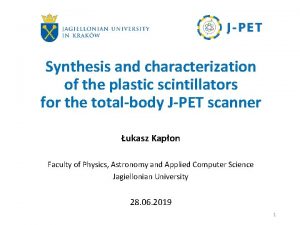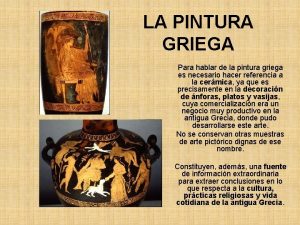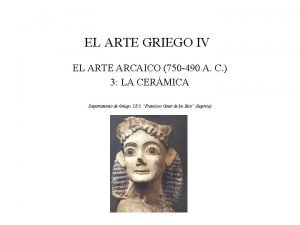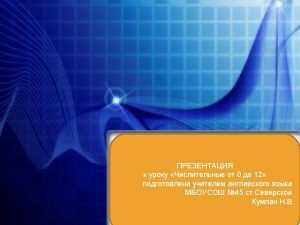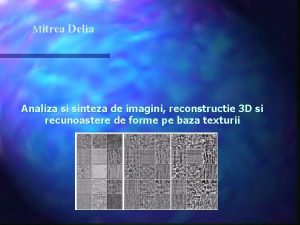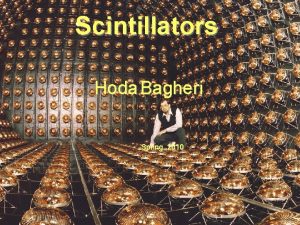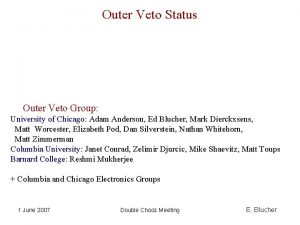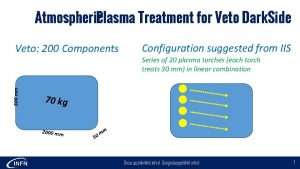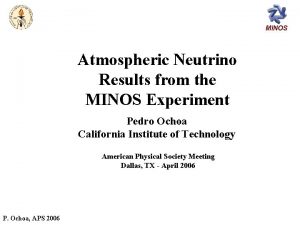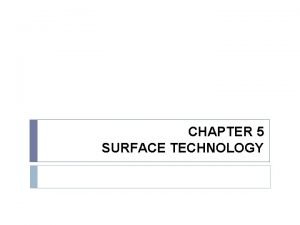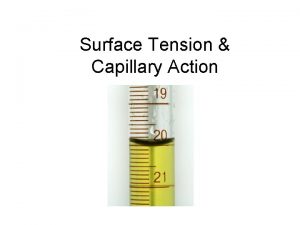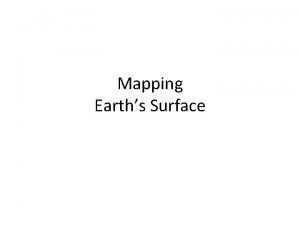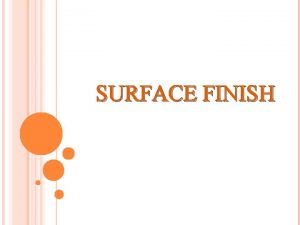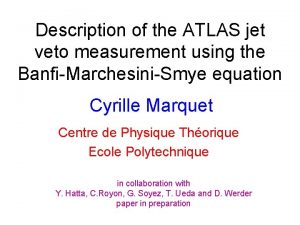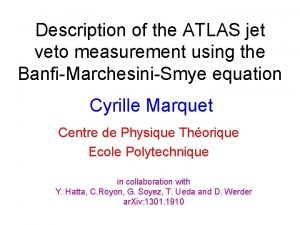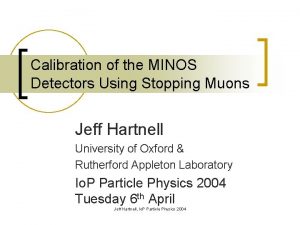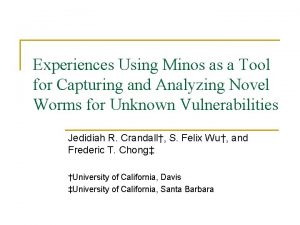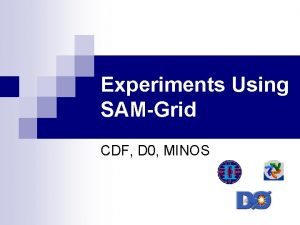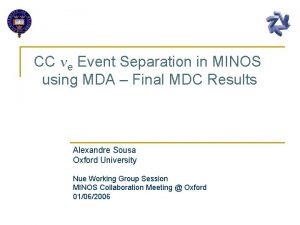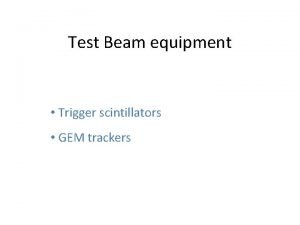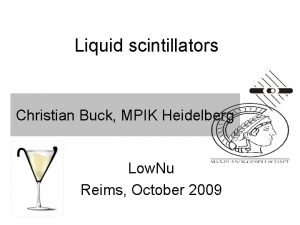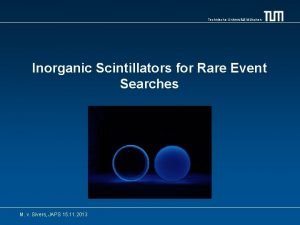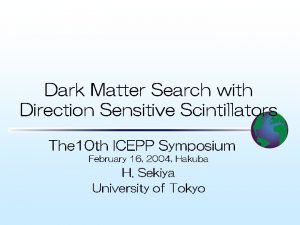Using MINOS scintillators as a surface veto Delia



























- Slides: 27

Using MINOS scintillators as a surface veto Delia Tosi / Chris Wendt UW Madison 1/26/15 Gen 2 Workshop 1

References for these slides • Slides from MINOS workshops, for example: – http: //www-offaxis. fnal. gov/workshops/stanford 03/transparencies/micha el_minosscin. ppt • Public reports, for example: – www-numi. fnal. gov/minwork/info/tdr/mintdr_5. pdf 1/26/15 Gen 2 Workshop 2

Basic unit 8 m • 1. 0 cm x 4. 1 cm Dow Styron 663 W polystyrene + wavelength shifters PPO (1%) and POPOP (0. 03%) [ 300 T, 600 km of 4. 1 cm 2] Clear groove • WLS Fiber: Kuraray double-clad 1. 2 mm diam. , 175 ppm Y 11 : shifts blue light to green [780 km] 1/26/15 Gen 2 Workshop Ti. O 2 CAP Reflector 3

Test performed on strip and unglued fiber • Strip and fiber were put in freezer and temperature was cycled a few times down to -80 C (in steps and in one shot) • Stress test (banging the strip against solid surface) was performed several times imposing harsh temperature change • Ti. O 2 does not show any sign of deterioration, fiber looks good and kept flexibility 1/26/15 Gen 2 Workshop 4

Module tests • We got 4 pieces of scintillator panels from MINOS far detector: – 2 pieces have optical connectors (OC) – 2 pieces have no connectors • Cables: – 2 (clear fibers): OC assembly – 1 (clear fibers) : OC assembly single fibers • Electronics: – MCPMT assembly + 2 “cookies” to feed fibers (see slides later) 1/26/15 Gen 2 Workshop 5

Far detector module layout Clear Fiber: Like WLS, no fluor, 1100 km of fiber built into cables with 20/28 fibers. • Two center modules have coilhole cutout 1/26/15 3 2. ~ ’’ 90 s as yp l. B • Four 28 -wide modules on edges 28 28 20 Co i • Four 20 -wide modules in middle m • 8 modules per plane 20 20 Gen 2 Workshop 20 28 28 6

Module overview Assembly Drawing for manifold Top variable width seal Top Al cover • Module: assembly of scintillator strips wrapped by aluminum sheets. • WLS fibers are routed through end manifolds to bulk optical connectors. • Modules, connectors and cables are light -tight (until you open them). Light Case Top Al light case Fiber routing manifold Connector Manifold base with fiber grooves Bottom Al light case Variable width seal Bottom Al Cover Bottom variable width seal 1/26/15 Light injection cover Light injection manifold Optical Gen 2 Workshop connector Formed Al cover 7 Module parts for “straight-out” manifold

Cables 1/26/15 Gen 2 Workshop 8

Electronics Cookie with fibers PMT Mounting Components Alignment window (not installed) PMT jacket Adjustable mounting bracket (alignment) M 16 PMT Spring loaded PMT base Fiber Layout • Hamamatsu R 5900 multi-anode PMTs: – 16 pixel tubes for the far detector (pixel size 4 mm x 4 mm) – 64 pixel tubes for the near detector (pixel size 2 mm x 2 mm) 1/26/15 • • Gain of 106 consistent to x 2 (M 16) or x 3(M 64) QE at 520 nm typically 13. 5% Good single pe peak Gen 2 Workshop Very fast signals and low time jitter. 9

Expected performance Number of observed photoelectrons • Light output: 10. 6 p. e. reading out from both sides for a 2 Ge. V muon (5. 5 p. e. min) • Time measurement: < 2 ns per strip for signals > 10 p. e. • Calibration: • Relative near/far energy response to within 2% • Absolute hadronic energy response to within 5%. • Performance variation vs time: • Decay of fluors • Monitored with calibration devices (laser, muons) Individual Strip Responses Distance along the module (m) Do we need to include a calibration device in out prototype? 1/26/15 Gen 2 Workshop From reference 10

Making our own small test module W = 32 inches L = 24 inches Fits in the Chamberlin freezer 1/26/15 Gen 2 Workshop 11

1/26/15 Gen 2 Workshop 12

Toray PFDU-FB 1000 1/26/15 Gen 2 Workshop 13

• Fiber connected to 2” PMT Hamamatsu RD 2759 (2 k. V – 1 e 7 gain) connected to mainboard • DOM Platypus placed under strip and connected in LC mode 1/26/15 Gen 2 Workshop 14

Test of mini module • Goal of planned test: – How much light we get from a muon? – Glue is expected to brittle at low temperature. Does this effect the light output? By how much? – Planned test: • Run at room temperature and verify we can see a signal • Monitor performance vs decreasing temperature • Inspect visually the assembly after temperature cycle • We ran a first test at room temperature • Computer died shortly afterwards so we have not gone down in temperature 1/26/15 Gen 2 Workshop 15

Platypus DOM plots 1 SPE signal in Ch 0 at ~6 m. V Ch 1 muon signal at 360 m. V ~ 65 SPE We select pulses in sync -100 ns to +100 ns to a signal in ch 1 DOM > 0. 2 V 1/26/15 Gen 2 Workshop 16

Scintillator plots Peak at 2. 5/1. 2=2 SPE 1/26/15 Gen 2 Workshop 17

What’s next • Set up a new computer to take data • Take measurements at room and low temperature – Possibility to improve coupling with splice and coupling gel – Need a plan B if glue fails catastrophically • Switch to electronics for deployment • Test the whole setup in freezer at PSL 1/26/15 Gen 2 Workshop 18

If we need to build something different Many things can be studied and improved: • Light output dependencies: – Light output <linear with scintillator thickness but depends on aspect ratio. – Light output inversely proportional to strip width (actually about 1. 3 x for 2 vs 4 cm. ) – Light output with two fibers = 1. 8 x light with one fiber. – Light output vs fiber radius ~ R 1. 3 • Difference between fiber in hole vs fiber in groove: – A fiber glued into the groove is 1. 8 times better than a dry fiber – A dry fiber in the groove is 10% worse than a dry fiber in a hole • Increase thickness? or use more strips on top of each other? 1/26/15 Gen 2 Workshop 19

Backup 1/26/15 Gen 2 Workshop 20

From reference • The most significant design critereon for the far detector was the light output. – >4. 7 pe’s/muon (2 Ge. V muons) for the average sum of two strip ends. • The measured light output is almost a factor of two higher than the design requirement. Mean = 10. 6 pe’s (~8. 5 for 2 Ge. V muons) Light output is stable! Light output measured for all strips for muons in the far detector. The light output is corrected to 1 cm pathlength per plane but is not corrected for PMT gain variations. Average light output for one-side of readout vs plane number in the detector. (Not corrected for pathlength or gain variations). This shows the uniformity in the hardware and raw response.

• The time resolution of the MINOS scintillator system is determined primarily by the decay time of the Y 11 fluor in the WLS fiber ~ 8 ns. • The time resolution for each scintillator strip is expected to be ~2. 5 ns based on the photoelectron statistics for muons. • Current measurement of resolution using downgoing muons in the far detector is s=2. 6 ns/plane. • The direction of muons can be determined with ~ 10 planes for contained vertex events. • To distinguish upgoing from downgoing through-going muons ~ 20 planes are needed. Distribution of measured time residuals for muons Passing through all strips in the far detector. The Time resolution of 2. 6 ns is calculated from this data. From reference

Cookie with fibers PMT Mounting Components View of PMT boxes installed on the far detector Alignment window (not installed) PMT jacket Adjustable mounting bracket (alignment) M 16 PMT Spring loaded PMT base Connector pair 1/26/15 • Far detector (shown) • 3 M 16 PMTs/box Workshop • 8 fibers per. Gen 2 pixel nd t-e ics n o Fr ctron ele 23

• Scintillator System – – – – • • • Scintillator WLS Fiber Module Components Module Fabrication Clear Fiber Cables PMT Boxes EDIA/Setup $k Production $k Total $k 2950 12100 15050 750 220 400 1100 180 200 2430 1170 1400 2090 1670 940 3180 1390 1800 3500 2190 1850 1140 Readout Electronics (32 k channels) Steel 1000 Installation 1000 Cavern/outfitting Scintillator system cost/m 2 Scale-up by factor of ~4? 3500 3800 $470 $330 4500 4800 12000 $580 $400

• Scintillator Module Components – Extruded Scintillator • • • MINOS Cost = $9/kg (about 2 m) includes QC checks, handling, delivery. New die ~$10 k New profile ~$50 -100 k (depends on how radical the changes are) New vendor ~$100 k+ (depends on competence of vendor) Kuraray: MINOS quote ~$13/kg… MINOS did not accept. This was the only competing offer. – WLS Fiber: • • MINOS cost = $1. 55/m On average need Lscin + 0. 7 m x (1, 2) Small production cost ~ $3. 50/m (~10 km) Cost scales as ~R 2 and light as R 1. 3. Biggest practical radius was good value for MINOS but maybe not if lower light is OK. MINOS fiber is 1. 2 mm diameter. 1. 4 mm is probably the largest possible using these techniques.

• Scintillator Module Components (cont. ) – – Aluminum ~ $12/m 2 of module (2 skins) Manifolds, etc ~ $200/module (~$5 -10 k startup for different styles) Glues, expendables ~$12/m 2 of module Connectors ~$5/ module • Scintillator Module Assembly – – – ~20 hours/module for MINOS, style of module matters very little Setup for different style modules ~ 2 weeks = 800 hours Setup with MINOS equipment at new site and new crew ~ 4000 hours New equipment equivalent to MINOS ~ $400 k. Cost at Caltech rate for MINOS ~$400/module • Full module costs: – MINOS Cost: $660/module + $180/m 2 : 8 m module = $2100 = $260/m 2

• Readout Component Costs – Clear fiber cables • • • $1. 15/m for raw clear fiber $1. 00/m for conduit $8/ cable for connectors and shrouds 2 hours/cable assembly labor (~$44/cable) Example: 24 fibers x 4 m = $170 – PMTs • • M 16 ~ $760/tube + $40/base + $200/mounting +$400/routing box = $1400/tube In MINOS far detector: $1400/tube = $88/pixel = $11/fiber end readout (8 fib/pix) M 64 ~ $1300/tube + $50/base + $200/mounting + $400/routing box = $1950/tube In MINOS near detector: $1950/tube = $30/pixel = $30/fiber end readout (1 fib/pix) – Other stuff: (LEDs, HV…) ~$200 k for a “small” system – Electronics: • MINOS far detector: ~$400 k + $40/channel (pixel, $5/fiber end) • MINOS near detector ~$600 k + $200/channel (pixel/fiber end) • DAQ system ~$300 k
 Plastic scintillators: chemistry and applications
Plastic scintillators: chemistry and applications Elected only by plebeians, veto power, 1 year term
Elected only by plebeians, veto power, 1 year term Veto a law
Veto a law Maysville veto
Maysville veto Corredores durante los juegos panatenaicos
Corredores durante los juegos panatenaicos ánfora ática, decorada con heracles y el toro minos
ánfora ática, decorada con heracles y el toro minos Minos kokkinakis
Minos kokkinakis Anfora atica heracles y el toro de minos
Anfora atica heracles y el toro de minos Plus minos
Plus minos Son of minos
Son of minos Delia crawford
Delia crawford Appa cybersecurity scorecard
Appa cybersecurity scorecard Les paveurs van gogh
Les paveurs van gogh Melinda ramsey long
Melinda ramsey long Estrategias construccionales
Estrategias construccionales Delia derbyshire doctor who theme
Delia derbyshire doctor who theme Depreciation equation algebra
Depreciation equation algebra Delia florea
Delia florea Delia lerner frases
Delia lerner frases Delia mitrea
Delia mitrea Alumnos pragmáticos o acomodadores
Alumnos pragmáticos o acomodadores Delia florea
Delia florea Delia derbyshire doctor who
Delia derbyshire doctor who Delia florea
Delia florea Delia platura cebola
Delia platura cebola Isabela delia popa
Isabela delia popa Jesse delia
Jesse delia Andreea pascu
Andreea pascu
